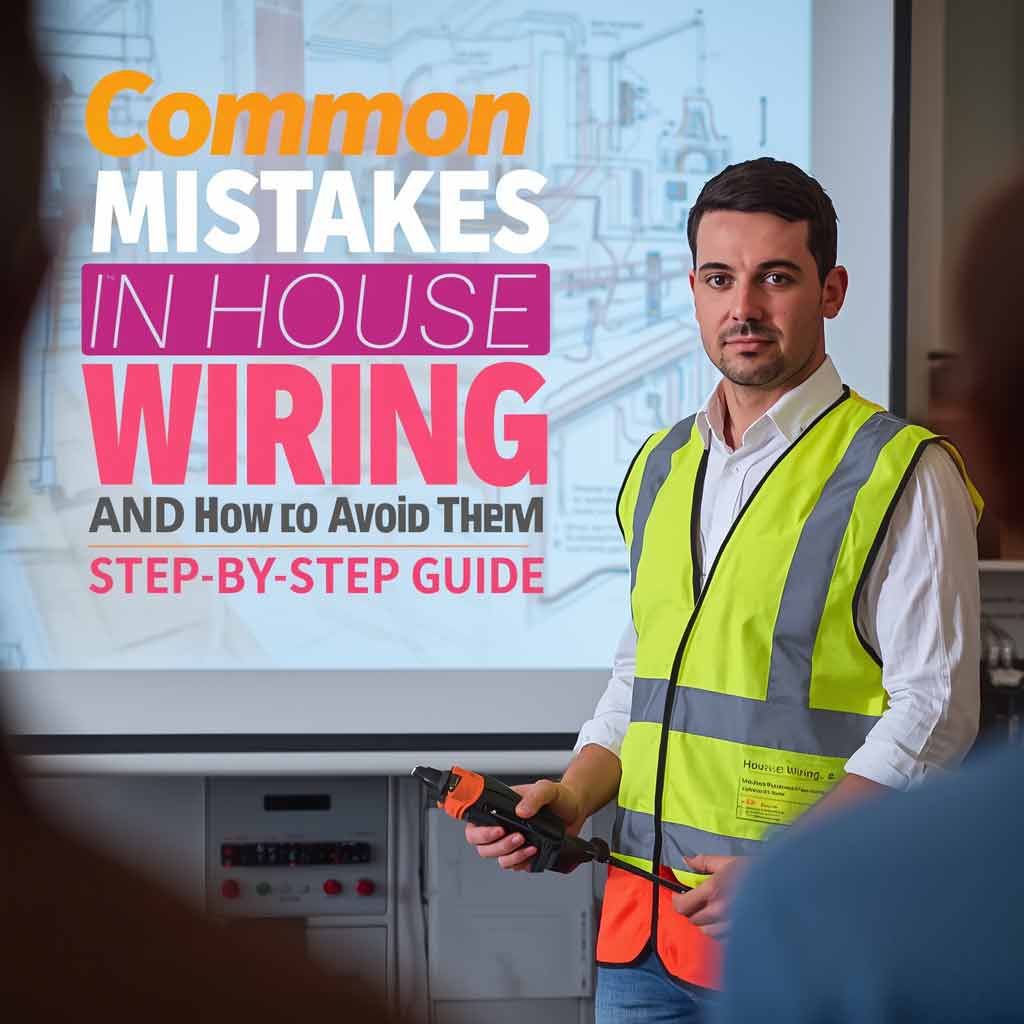Common Mistakes in House Wiring and How to Avoid Them
Common Mistakes in House Wiring and How to Avoid Them
House wiring is one of the most crucial parts of any building’s electrical system. A small mistake can lead to major safety hazards such as short circuits, electric shocks, or even house fires. Many homeowners and even some inexperienced electricians make common mistakes in house wiring without realizing how dangerous they can be.
In this article, we’ll highlight the most frequent wiring errors people make and explain how to avoid them with safe, smart, and professional practices.
Why Proper House Wiring Matters
Proper wiring ensures your home’s electrical system runs safely and efficiently. Faulty wiring can cause:
- Overheating of wires
- Voltage drops
- Damage to expensive appliances
- Electrical fires and shocks
By understanding and avoiding the most common mistakes in house wiring, you can protect your home and family from dangerous electrical hazards.
Using Wires of the Wrong Size
The Mistake:
Using cables that are too thin for the electrical load.
Why It’s Dangerous:
Thin wires cannot carry the required current, which causes overheating and may start a fire.
How to Avoid:
- Always check the wire gauge (AWG) or cross-sectional area (mm²).
- Use 2.5 mm² wires for power outlets and 1.5 mm² for lighting circuits (standard in many countries).
- Consult an electrician or refer to your local electrical code.
Ignoring Proper Grounding (Earthing)
The Mistake:
Skipping the grounding connection or using low-quality earthing rods.
Why It’s Dangerous:
Without grounding, fault current cannot safely flow to the ground. This can cause electric shock or appliance damage.
How to Avoid:
- Use a proper earthing system with copper or galvanized steel rods.
- Check resistance regularly (should be below 5 ohms).
- Connect all metal parts like switches, sockets, and appliances to the grounding line.
Overloading a Single Circuit
The Mistake:
Connecting too many devices to one circuit line.
Why It’s Dangerous:
Overloaded circuits lead to breaker trips, voltage drops, and overheated wires.
How to Avoid:
- Divide circuits based on room or appliance type.
- Use dedicated circuits for high-load devices (AC, refrigerator, washing machine).
- Use MCBs (Miniature Circuit Breakers) to protect each circuit.
Loose or Poor Connections
The Mistake:
Leaving loose wire joints inside switches or sockets.
Why It’s Dangerous:
Loose connections generate sparks and heat, increasing fire risks.
How to Avoid:
- Always use proper wire connectors or lugs.
- Tighten all terminals securely.
- Check connections regularly, especially for heavy-load points.
Not Using Junction Boxes
The Mistake:
Joining wires directly inside walls or ceilings without junction boxes.
Why It’s Dangerous:
Without protection, wire joints can be damaged by moisture or mechanical stress, leading to short circuits.
How to Avoid:
- Always enclose joints inside junction boxes.
- Seal boxes properly with covers.
- Ensure accessibility for future maintenance.
Mixing Different Wire Types
The Mistake:
Combining aluminum and copper wires or using different insulation materials in one circuit.
Why It’s Dangerous:
Different metals have different expansion rates, causing loose joints and oxidation.
How to Avoid:
- Stick to one wire material per circuit.
- If joining copper and aluminum is unavoidable, use special connectors (Al-Cu lugs).
Skipping Safety Devices
The Mistake:
Not installing RCD (Residual Current Device) or ELCB (Earth Leakage Circuit Breaker).
Why It’s Dangerous:
Without RCD/ELCB, small leakages or electric shocks can go undetected, causing injury or fire.
How to Avoid:
- Install an RCD/ELCB in your distribution board.
- Test it monthly to ensure proper operation.
Incorrect Switch or Socket Placement
The Mistake:
Installing switches or outlets too close to water sources or at inconvenient heights.
Why It’s Dangerous:
Risk of electric shock, especially in kitchens or bathrooms.
How to Avoid:
- Keep switches at least 1 meter away from sinks or water pipes.
- Maintain standard height – switches at 4–5 ft, sockets at 1–2 ft from floor level.
Poor Planning and Labeling
The Mistake:
No circuit plan or labeling in the distribution board.
Why It’s Dangerous:
Makes maintenance confusing and time-consuming.
How to Avoid:
- Label each circuit (e.g., “Living Room Lights”, “Kitchen Outlets”).
- Keep a wiring diagram of your home for future reference.
DIY Wiring Without Proper Knowledge
The Mistake:
Homeowners trying to do electrical wiring without training.
Why It’s Dangerous:
Lack of technical knowledge can lead to unsafe installations and serious hazards.
How to Avoid:
- Always hire a licensed electrician for wiring and inspection.
- If you’re learning, start with a basic house wiring course under supervision.
🔗 Related Course: House Wiring Training – New Hope Training Center
House wiring might seem simple, but even small mistakes can cause massive problems. By avoiding the common mistakes in house wiring, you ensure a safe, reliable, and long-lasting electrical system.
Whether you are an electrician, a student, or a homeowner, always follow standard wiring practices, use quality materials, and prioritize safety. Remember: a safe connection today prevents accidents tomorrow.


